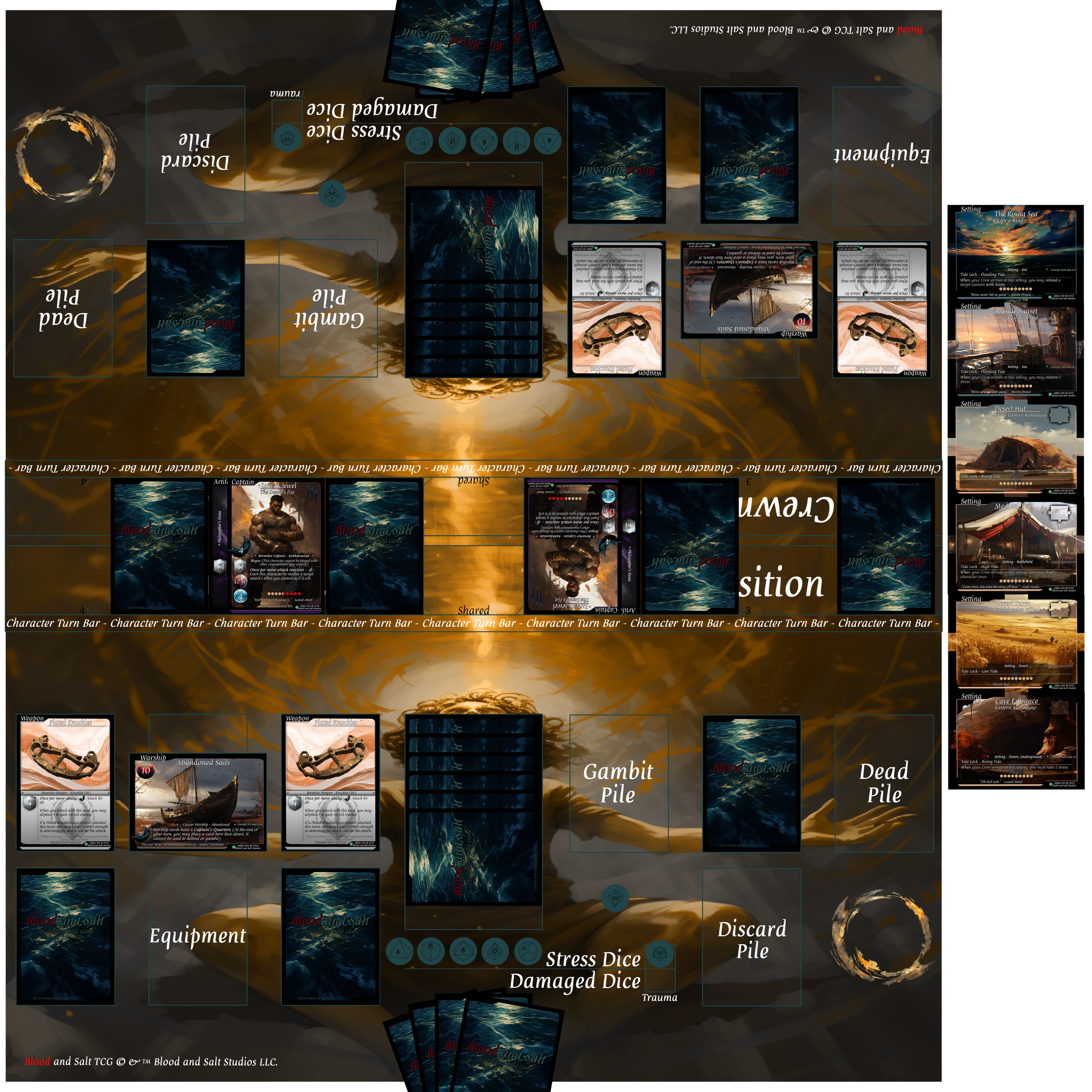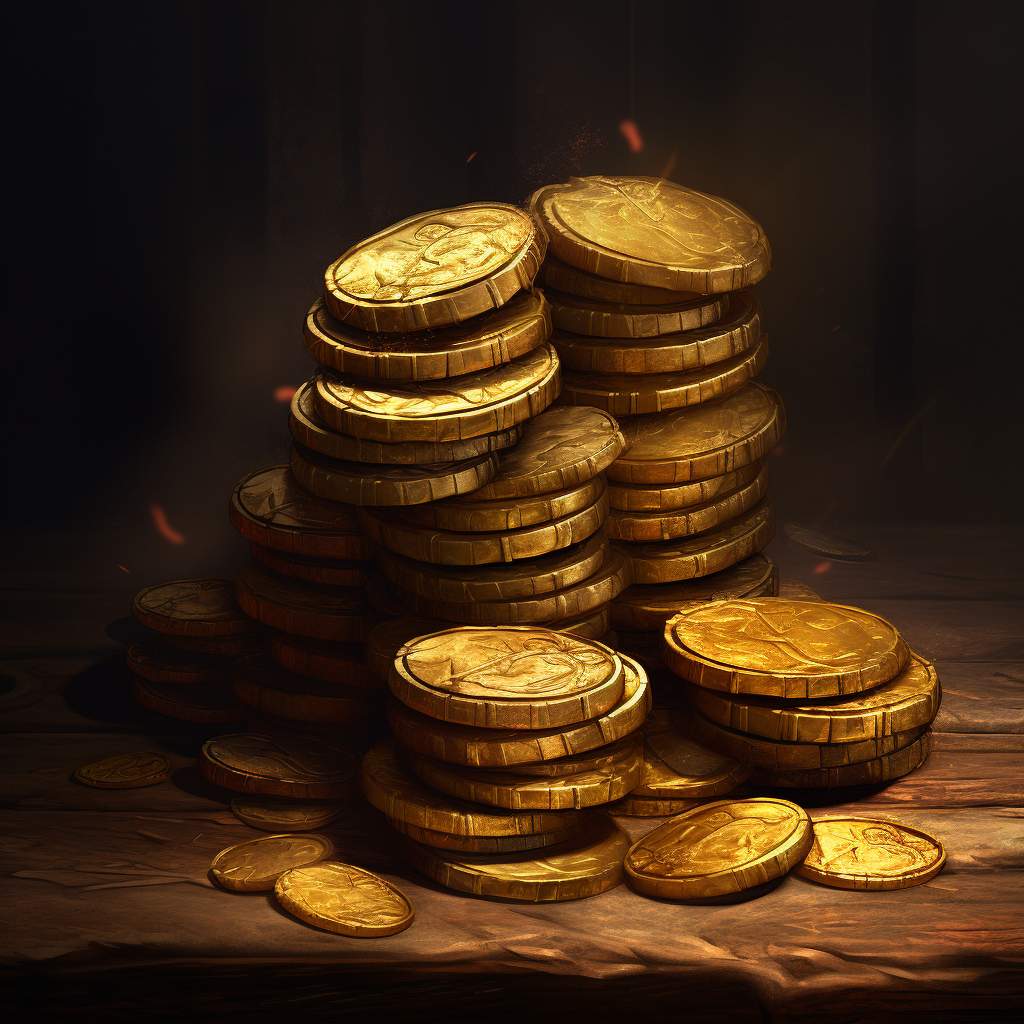Formats
TCGs are known for their versatility of play with new formats being explored every day. There is value in each of these formats but we want to be careful in selecting the formats we officially support as to ensure each of the Player bases is healthy and available to players as they wish to play them. With that said, our goal is to design fun and exciting formats that push the limits of our TCG design. Here we discuss in summary some of the marque and unique formats we have enjoyed in our tests of Blood and Salt TCG’s versatility and design space.
Constructed Formats
Sea Dogs
Sea Dogs is a constructed format and is the quickest way to get in a game of Blood and Salt TCG. It is the recommended starting point for new players.
Decks being smaller and players reaching the endgame faster all make Sea Dogs great for those who want to enjoy the social aspect of card gaming or want to enjoy many games in a session.
Games follow the constructed layout using settings, equipment, a full sweep of Crewmembers, and a sideboard (inventory). 2 of each unique card allowed. After 6 settings over 3 regions, the world has flooded.
Games are intended to be 35 minutes. Best of 1.
Sailfinders
Sailfinders is the marque constructed format in Blood and Salt TCG and is the format intended for players coming from Sea Dogs who want a deeper and more strategic game.
Players choose a Captain, build a crew up to 4 characters, and fill out their possessions and inventory with powerful and unique abilities to prepare for the war on attrition that is exploring. Manage your wounds and stress and push your Crew to their limits in the pursuit of power.
Games follow the constructed layout using settings, equipment, a full sweep of Crewmembers, and a sideboard (inventory). 3 of each unique card allowed. After 9
settings over 3 regions, the world has flooded.
Games are intended to be 35-50 minutes. Best of 1.
Limited Formats
Draft
Draft is the marque limited format in Blood and Salt TCG. Each booster box and pack construction is designed from the ground up with draft in mind as a major format.
When performing a draft format, players each start with 3x booster packs, 1 of them being a draft starter pack labeled “starter pack” and 2 of them being non-starter packs. Each player will start by opening the draft starter pack from the back, taking the first 3 token cards, and then placing the rest of that pack face-down in front of them. These 3 tokens are all Captain cards. Each player will then proceed in the draft as follows:
Draft Captains passing cards to the right.
Draft the remainder of the face-down pack 1 passing cards to the left.
Set aside setting tokens from pack 2 and then draft pack 2 passing cards to the right.
Set aside setting tokens from pack 3 and then draft pack 3 passing cards to the left.
Draft all Setting tokens passing cards the the right.
Players then construct a 30 card minimum deck using any of the 3 chosen Captains they have drafted.
Games follow the constructed layout using settings, equipment, a full sweep of Crewmembers, and a sideboard (inventory). Thought it is common to have less than a full set off all card slots so you will have to use what you have drafted to its fullest. Unlimited amounts of each unique card allowed. After 6 settings over 3 regions, the world has flooded.
Games are intended to be 35 minutes first being played in a Swiss format followed by top cut if needed. Best of 1.
Sealed
Sealed is a limited format that is easy to get started with and a perfect format for newly explored card pools.
Each player is given 6 booster packs and tasked with building a deck resulting in games where players find sporadic and odd combinations of cards from their card pool to take on their opposition. Great for games between players with fewer packs to open or pre-release events.
Games follow the constructed layout using settings, equipment, a full sweep of Crewmembers, and a sideboard (inventory). Thought it is common to have less than a full set off all card slots so you will have to use what you have drafted to its fullest. Unlimited amounts of each unique card allowed. After 6 settings over 3 regions, the world has flooded.
Games are intended to be 35 minutes first being played in a Swiss format followed by top cut if needed. Best of 1.
Multiplayer Formats
Armadas
Armadas is a unique format for Blood and Salt TCG that acts as the primary multiplayer format for the game.
Forget what you knew in this all-out naval format where every setting must be an ocean and every Player Captains a warship with their crew. Designed for 4 players, this format takes each player and puts their Crew into the heat of the action of being on a warship, tasked with reloading cannons and tossing water from their sinking ship. Warships naturally are the main event as the traditional warship types of Runners, Carriers, Leviathans, Breachers, and Icebreakers each make use of their abilities perfect for players seeking a chaotic naval conflict. Sink a warship and you will repair your own, but don’t sink a warship too soon. Once the first warship sinks, each remaining player will have 1 more turn to be left with the highest remaining health. The player who does wins.
All ocean settings or simply the card backs make the naval playing field.
Games follow the multiplayer layout using settings, equipment, a full sweep of Crewmembers, and a sideboard (inventory), and 2 Captains. This mode is also “singleton-by-name”, meaning there can only be 1 of each unique card allowed of the same name. Additionally, warship turns and character turns are shared for each player, meaning if you want to move your ship you must expend a character turn to do so, though rotating a ship does not take a turn. Players may still use their Captain’s Quarters as normal, but some warship abilities will change as found on the back of those cards to function for Armadas.
Reminder: A unique card in Blood and Salt TCG is a card that has both a different Card Name and a different Card Color!
Games are intended to be 35 minutes.
Unique Formats
World (PvE)
World is the marque unique format in Blood and Salt TCG bringing Player vs Environment (PvE) to the forefront of the design of Blood and Salt TCG.
Due to Blood and Salt’s unique design of side-view positional combat, a setting path, and the inherent design of booster packs being randomized in a set, B&S: World brings players a TCGRPG experience like none other that encourages cooperative role-based play where players hunt the bounties of future playable Captains, Bosses, and discover secret layers and lore, and much more in a grim world dripping with flavor.
Each player starts with their chosen Captain, that Captain’s distinctive weapon, and an abandoned warship and set out to explore the perilous world of Agmaloria, by salt water or by land, as it does its best to drive your Crew to insanity as your Crew seeks to become the greatest force to ever sail the seas. Open packs, plunder loot, pack your provisions, build unique decks without limits, and discover the world as it unfolds in front of you.
And as all renowned bounty hunters say, “May death await you at every turn”.
PvE Board without Environment Cards
PvE Board with Environment Cards
Games follow the PvE layout using settings, equipment, a full sweep of Crewmembers if found, and a sideboard (inventory). Unlimited of each unique card allowed. Players share the zones at the bottom of layout also sharing character turn totals and the Captain’s Quarters.
Games are intended to last several sessions, over short (9 Setting), medium (18 Setting), and long (27 Setting) explorations as chosen by the players.
Welcome (Learning The Game)
Welcome Format is a unique format intended for players looking to teach others the game of Blood and Salt TCG.
Given print and play decks or physical decks of the same card pool, both players will play with identical Luwal Welcome Decks, each with a Captain, Philosopher’s Stone, Weapons, Abandoned Warships and a pre-made card pool that focuses on the basics of the game. Here players will learn about character turns, turn order, traveling, and more.
Games follow the welcome layout using the Luwal Welcome Deck that contains settings, and an incomplete sweep of Crewmembers, weapons, and a warship. Each player will have the same card pool. After 6 settings over 3 regions, the world has flooded.
Games are intended to be 15 minutes.
Duels (1v1s)
Duels are a unique format intended for players seeking deep and rewarding character-driven gameplay where Players are set in 1v1, Captain versus Captain combat.
Designed to deliver combat that is close and gritty, Duels take stress damage along a different axis, where blocking and deflecting over time lead to trauma, that rather than driving the Captain to insanity, brings that Captain closer and closer to breaking their “stance”. Take enough trauma or deal enough trauma, and a Captain will be able to “stance break” their opponent leaving them open to a deathblow, winning the duel.
Games follow the duels layout using equipment, just your Captain, and a sideboard (inventory). 3 of each unique card allowed.
Games are intended to be 20-25 minutes.
Bounty (Event Specific)
Bounty Format is a unique format intended to be used for bounty events.
Bounty events are a special event type that transforms traditional tier 1 local events into a new and genuine event to the TCG scene where Captains who have acquired enough Renown Points over the course of their existence in the game are being hunted for collection. These Captains have a bounty on their head and by losing enough matches will result in the death of that Captain and rotation of that Captain from the Captain pool as well as bounty collected prizing for the player(s) that collect the bounty. This would include special full alternate art Captain cards with bounty collected full alternate art corpse card backs and more.
More on this new and exciting format and the Renown System coming in an upcoming post.











